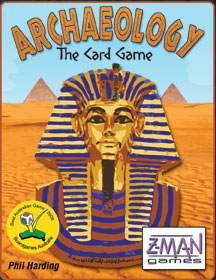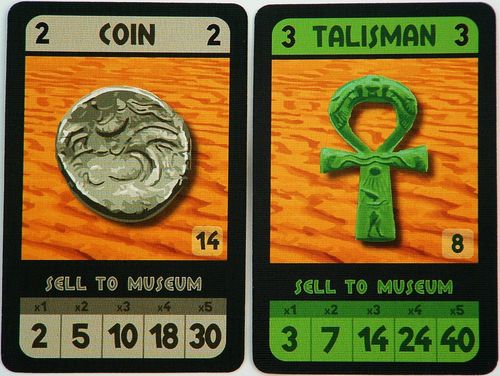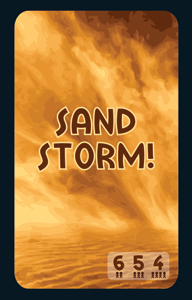NOTE – THIS REVIEW IS FOR THE FIRST EDITION OF ARCHAEOLOGY THE CARD GAME – THERE IS A NEWER ADDITION WITH UPDATED ART AND A FEW ADDITIONAL GAME MECHANICS. THE BASE GAME PLAY REMAINS THE SAME
Game Review:
I love reading about and studying history. The subject of Archaeology has always fascinated me, so this title jumped out to me. Unfortunately, the game only has a passing connection to discovering secrets of the past, but what it does have is a batch of fun light set-collection style game play.
For us, light card games are a weakness for our wallets. Games that are easy to learn, easy to play, easy to teach, and best yet, easy to carry with you are hard to resist. Archaeology is a great example.
In Archaeology: The Card Game players take turns “digging” by drawing a card from the draw stack to try to create sets of various artifacts, ranging from Pharaoh’s Mask down to Pot Shards. The revealed item is added to their hand. At any time during their turn, a player make place cards from their hand face up in front of them, adding them to their “display”.
Different items and different sets have different point totals. For example, the Pharoah’s Mask has an innate value of 4, but a complete set of 4 Pharaoh’s Mask, if placed in the display, is worth 50 points. However, once a set is placed in the display, it can not be altered or added to, so if you have a set of 2 Pharaoh’s Mask in your display and managed to acquire a third, it would have to be added as a separate section in the display and would count for less points.
To further add to the flexibility, there is a market of items where a player can trade in cards from their hand for cards in the market, based on the cards innate value. So for example, a player could turn in a Pharaoh’s Mask (value 4) for 4 Pot Shards (value 1).
There is a catch to this process, however – Sandstorms and Thieves. If a player turns up a Sandstorm card when they “dig”, that means a Sandstorm has struck the dig site. All players must discard half of their current hand, rounding down! This does not affect cards in the display. All discarded cards go into the market.
If a player turns up a Thief, they can steal a card from another player’s hand at random.
There is one additional special card to mention – Maps. At the beginning of the game, a set of 3, 5, and 7 cards are stacked face down next to a pyramid card. If you acquire Map cards, you can turn them in to automatically gain the appropriate set of items – 1 map for the 3 card stack, 2 maps for the 5 card stack, and 3 maps for the 7 card stack. Maps have an innate value of 3, so sometimes it’s a tempting prospect to trade them into the market instead of hanging onto them.
Play continues until the draw stack is empty. Players count up the points in their display area and the one with the most points wins.
Archaeology: The Card Game is fairly quick to setup, and easy to learn. There is a significant “press-your-luck” factor in the game, as you have to decide whether you want to get a partial set into your display or risk a Sandstorm wiping out half of your hand. The addition of the market allows for some good strategic decisions, I.E. do I hold on to my high value cards or turn them in for a complete set of low value cards I can immediately put into my display, for example.
The game scales well between 2 to 4 players via changing the number of Sandstorms. Even a 4 player game is relatively quick to play, with an average game lasting between 15 to 20 minutes. The box is small enough to fit into a pocket for perfect portability.
The art on the cards is decent, though not compelling. My one quibble is that the card backs are printed in one direction, meaning there is a definite up vs down. This can be a problem, in that during setup you add Sandstorms, Thieves, and Maps to the draw deck. If the two different sets of card backs are aligned differently, you can sometimes tell when a special card is to occur based on the direction of the card back. This requires a bit more attention during setup to keep the cards aligned, but it’s really only a minor annoyance.
Archaeology: The Card Game is fun light card game that’s quick to play and learn. If you like a certain amount of press-your-luck style gaming with light player interaction, this is definitely a game to check out. Recommended!
Archaeology: The Card Game
Designed by Phil Walker-Harding
Published 2007 by Z-Man Games
Board Game Geek Link
Sidekick Score
-
Art
-
Components
-
Fun
-
Rules
-
Replay
Summary
A fun light set-collection card game


